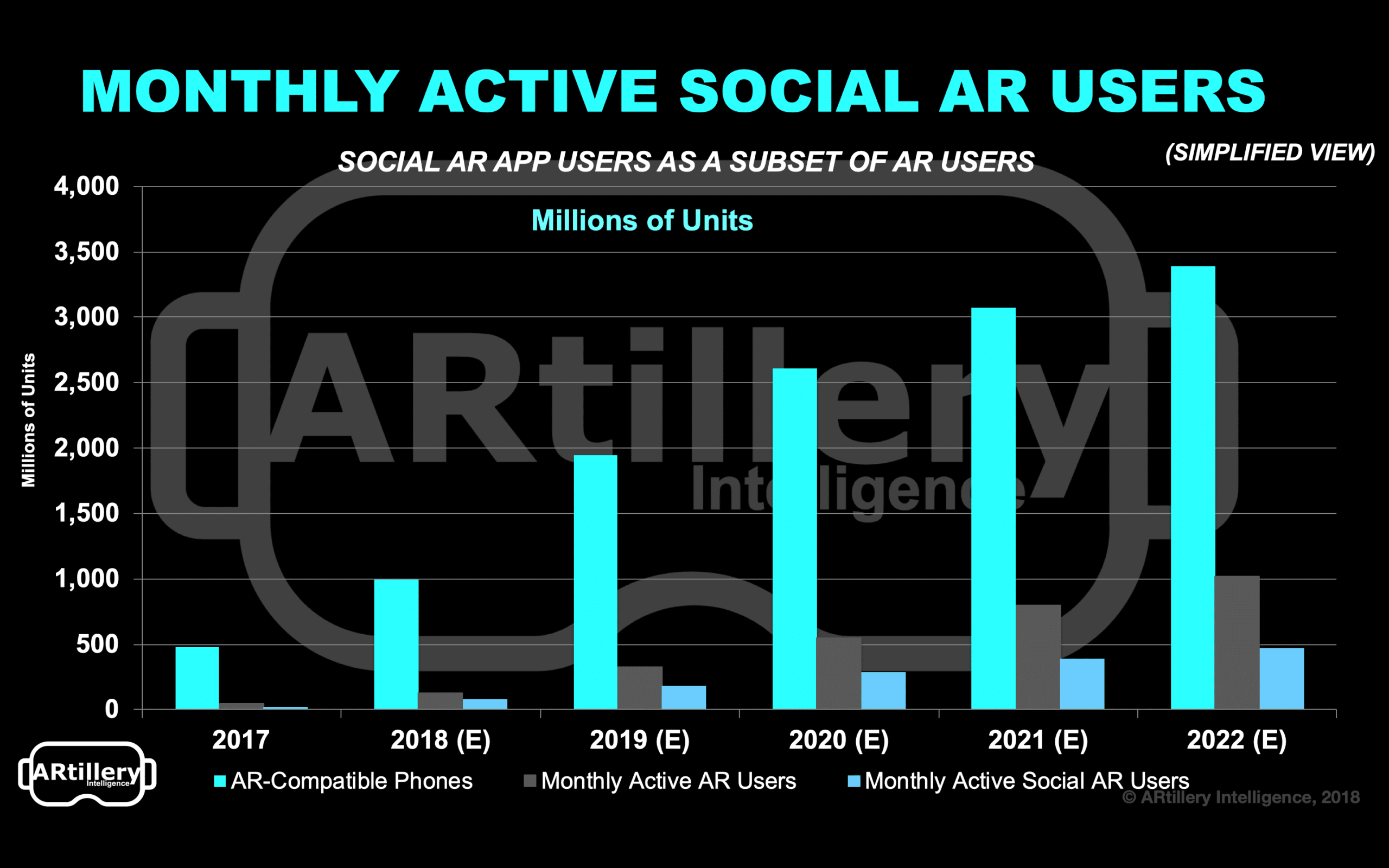
ARtillery Briefs is a video series that outlines the top trends we’re tracking, including takeaways from recent reports and market forecasts. See the most recent episode below, and past installments are here.
One of the biggest questions facing the AR sector is what (and when) will be its killer app? We’ve speculated that it’ll extend beyond the novel use cases we’ve seen so far. It will rather be more mundane utilities that engender all-day use cases and frequency, such as visual search.
We stand behind that claim, but another likely killer-app candidate is social AR, which is the topic of the latest ARtillery Intelligence report and episode of ARtillery Briefs (embedded below). In fact, social AR has already been validated in both mass appeal and real revenue.
So how is this playing out? Mostly through social lenses, which are an early leader among consumer AR use cases. Snapchat alone has 70 million daily active users for its AR Lenses. Along with Pokemon Go, it’s validated AR’s mass-market appeal, at least in certain forms.
But it’s also validated an AR business model, with more than than $400 million from branded lens ad revenue in 2018, which we project to grow to $2.5 billion by 2022. And ARtillery Intelligence survey data with Thrive Analytics further indicate demand for social AR (see chart below).

Metcalfe’s Law
Social AR’s potential is also grounded in an innate human need to connect with others. Historical evidence points to social infusion as a technology accelerant. We saw that in the web 2.0 era when the web went from a solitary experience to a very social one, and engagement skyrocketed.
This brings in the principles and advantages of network effect, which essentially state that value and utility grow exponentially with each person added to a given network. It’s an offshoot of Metcalfe’s Law. Social interaction can also fuel any technology through viral growth.
But how will that apply to Social AR? Think again about the leap from pre-web 2.0 to socially-linked experiences. But though AR lenses are great for reasons mentioned above, they’re limiting in that they’re asynchronous. They’re recorded in isolation then shared for remote consumption.
The true potential is rather with synchronous AR that’s experienced together in the same time and place. And that requires image persistence, multi-player functionality and other tenets of the AR cloud that are being pushed forward by startups like 6D.ai, Ubiquity 6, YouAR and others.

Place-shifting
Pumping the breaks a bit, though synchronous AR is opportune, it isn’t a silver bullet. It will unlock new possibilities and use cases, but synchronicity could also limit scale by forcing you to be in the same place at the same time, as opposed to the scale-amplifying tendencies of the web.
One of the reasons why the web engenders scale is its inherent ability to make the world smaller and to placeshift lots of people together. So the magic AR formula could end up being some combination of of synchronous play with asynchronous participation or viewing (think: e-sports).
Another disclaimer for multi-player AR is that it will require less friction than we currently see. The siloed nature and lack of interoperability that’s prevalent in mobile apps won’t work for dynamic social AR pick up sessions when everyone has to stop and download the right app.
That means the winners in social AR will likely be those that lessen friction for session launches. That could mean web AR as opposed to apps. It could also mean “AR as a feature,” product strategies that plant AR within well-travelled experiences, rather than standalone apps.

The Plurality
As for who brings us this vision, it will be several companies and social graphs. For example, Facebook could own a social AR cloud that’s a sort of a permissioned identity layer that lets you see and share info like friends’ status or mood through live AR overlays as you walk around.
Innovators like Ubiquity 6 will likewise enable AR layers that enhance or characterize our personalities. This could involve virtual style items, the exchange of which is a business model being validated today in communities like Fortnight — but taking place in the real world instead.
There will be lots of other players and moving parts as social AR materializes. It will be tied to the AR cloud, which is really several clouds or data layers that correlate to the companies building them. Either way, social AR already shows signs of real user demand, and a real business case.
For deeper XR data and intelligence, join ARtillery PRO and subscribe to the free AR Insider Weekly newsletter.
Disclosure: AR Insider has no financial stake in the companies mentioned in this post, nor received payment for its production. Disclosure and ethics policy can be seen here.
